Beihai Park is bordered to the east by the Palace Museum and Jingshan Mountain, to the south by Zhonghai and Nanhai, to the west by Xingsheng Palace and Longfu Palace, and to the north by Shichahai. It is number one among the top three most scenic lakes in Beijing City. Beihai Park is the most time-honored and best protected royal palatial garden in existence in China. With a unique garden design style, it represents the ultimate in ancient Chinese garden art and one of the infinitely precious human cultural heritages in the world.
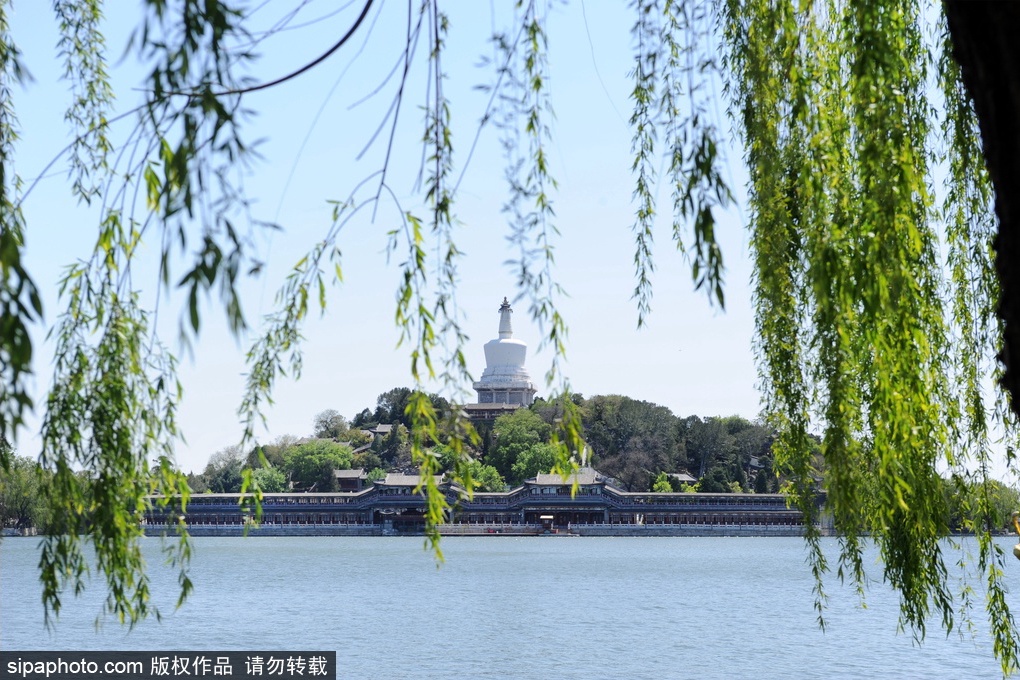
Beihai Park has a total area of 1,063 mu, of which 583 mu is water and 480 mu is land. Here, tower shadows in sunlight are reflected in the vast expanse of water lying in the fragrant embrace of green pines and verdant cypresses; airy pavilions, pagodas, and caves formed by stacked stones combine to create a gorgeous fairyland. The prototype of Beihai Garden was the fairyland described in an ancient Chinese mythology, The Story of the Queen Mother of the West. Its present-day layout is the result of its evolution in the Liao, Jin, Yuan, Ming and Qing dynasties. During the Warring States Period, legend had it that immortals with the elixir of life lived on the three celestial mountains—"Penglai," "Yingzhou" and "Fangzhang"— to the east of the Bohai Sea. In 221 BC, after he unified China, the First Emperor of Qin commissioned Xu Fu and some other alchemists to, together with thousands of virgin boys and girls, sail across the sea to find the elixir of life on the three celestial mountains, but to no avail. He then built an about-100-li-long pond, constructed the artificial Penglai mountain, and carved the shape of a 200-zhang-long whale out of stone in Lanchi Palace. Emperor Wu of the Han Dynasty did the same thing and couldn't find the celestial mountains either. Subsequently, he issued a decree building a large pool behind Jianzhang Palace and named it "Taiye Lake." The earth dug out of the ground was piled up in the pool to symbolize the three celestial mountains: Penglai, Yingzhou and Fangzhang. The emperors of later dynasties continued to build the "one pool, three mountains" near the palace. It was by this tradition that Beihai forest was built. Today's Beihai and Zhongnan represent Taiye Lake back then, and Jade Islet represents "Penglai mountain", Round City "Yingzhou Mountain" and Zhonghai Xishan Terrace "Fangzhang Mountain". Today, we can see not only dreamlike pavilions and pagodas on Jade Islet, but also legendary celestial-island scenes like Shenren'an, Lyugongdong and Tongxian Chenglupan. Beihai mirrors the basic elements of the superb gardening techniques that once were used to push the boundaries of landscape architecture and recreate the imagined garden of immortals. It also brings together China's achievements in temple gardens, Jiangnan-style literati gardens and religious art in a single grand, time-honored, and artistically superior garden. It is arguably a masterpiece of Chinese landscape architecture.
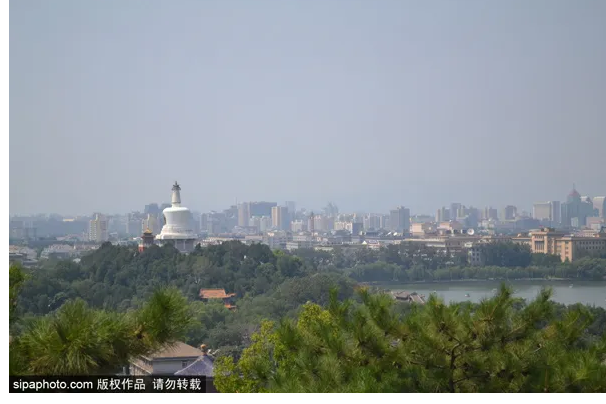
The 1,000-year-long history of Beihai Park closely tracks with the development of Beijing. Beihai was originally in the ancient channel of the Yongding River, which moved southward, leaving behind a wilderness dotted with ponds. In the Liao Dynasty, after Emperor Taizong (Yelv Deguang) made Yanjing his capital in the first year of the Huitong era (938 AD), he built "Yaoyu Temporary Palace" in White Lotus Pond (Beihai) in the northeastern suburbs of the capital and erected "Guanghan Hall" on the top of the island. According to History of the Liao Dynasty, "A hall for beating the heat (Guanghan Hall) lies at the westernmost end of the city, and decorated archways (called Yanjiaolou), workshops, Taoist temples, etc. cluster in the northeast corner." According to Illustrated Map of Beiping in the Hongwu Period, "Jade Islet was called Yaoyu in the Liao Dynasty." The above historical facts all prove that "Yaoyu Temporary Palace" existed. After Jin destroyed Liao, Yanjing was renamed "Zhongdu." "Yaoyu Temporary Palace" was expanded, and "Yaoguang Hall" was newly built in the second year of the Tiande era (1150 AD) under the reign of Prince of Hailing (Wanyan Liang) of the Jin Dynasty. Between the third year and the nineteenth year (1163-1179 AD) of the Dading era of the Jin Dynasty, Emperor Shizong replicated Genyue Imperial Garden in Bianliang (now Kaifeng in Henan Province), capital of the Northern Song Dynasty, and built Jade Islet. Large quantities of Taihu Lake stone were transported from Genyue Imperial Garden to Zhongdu to build rockery caves, and Daning Detached Palace was built in Yaoyu (Beihai) in the northeastern suburbs. It was then that the layout of imperial palatial garden Beihai as we know it today was basically created. At that time, the earth dug out of the ground for the construction of "Jinhai" was piled up to form an island and hills around the lake. The island was called "Jade Islet" and the lake was called "Xihua Lake." "Guanghan Hall" and other buildings were rebuilt. In 1264, Emperor Shizu (Kublai Khan) of the Yuan Dynasty decided to build his capital Dadu in the northeastern suburbs of Zhongdu. Between the first year and the eighth year of the Zhiyuan era (1264-1271AD), Kublai Khan expanded Jade Islet three times and rebuilt Guanghan Hall. Guanghan Hall is 120 chi wide from east to west, 62 chi deep and 50 chi high.
Here's some of famous scenic spots in Beihai Park:
Jade Islet
Jade Islet is called Qiongdao for short. It is also commonly known as "White Dagoba Hill" because of a white dagoba built on it. It is 32 meters high and 913 meters in circumference. The word "Qionghua" suggests gorgeous jade, therefore the name "Jade Islet" was believed to denote an island built of beautiful jade in the fairyland. And according to a fairy story, "Qionghua" are the flowers of the Qiong tree (here "Hua" is used to refer to flowers for it is a homophone of the character denoting flowers) on Penglai Island. It was believed that anyone who ate this flower would live forever. The use of "Qionghua" in the name suggests that the island was a replica of Yaochi Wonderland. A turret was built on the top of the mountain in the early Qing Dynasty. The Eight Banners Army were garrisoned there. Overlooking the entire city, it occupied a commanding position and would send out signals once there was a danger.
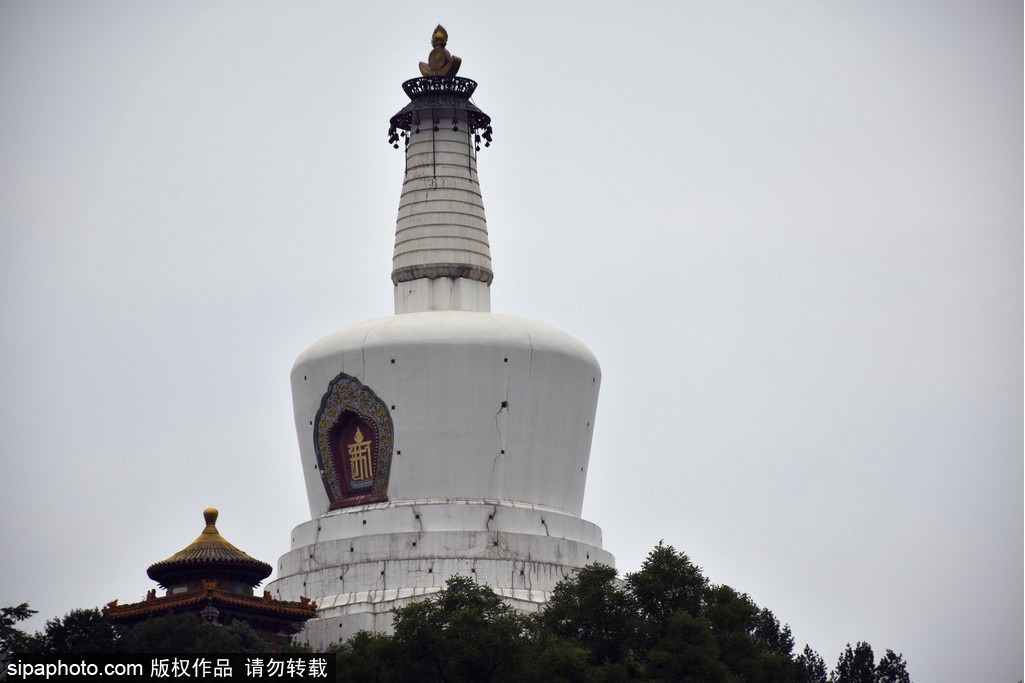
To the west of Qiongdao is the Hall of Felicity, where the emperors of the Qing Dynasty rested, discussed official matters, or held banquets while visiting the garden. Behind the Hall of Felicity is the Tower of Celebration where Qianlong Emperor and his mother used to watch games on the frozen lake in winter. On the northwest side is Yuegu (reading history) Tower, which houses 340 models of calligraphy for practice, over 210 prefaces and postscripts and 495 stone carvings created between the Wei Jin Southern and Northern Dynasties and the Ming Dynasty. The Model Calligraphy from the Hall of the Three Rarities inlaid on the inner wall is a carved copy of that in the Forbidden City. It is not a replica, but the original highly valued piece of calligraphy created in the Qianlong era of the Qing Dynasty. This area is also home to Linguang Hall, Yannanxun Pavilion and "Tongxian Chenglupan" halfway up the mountain.
On the northeast slope of Qiongdao are old trees that reach into skies. This is the so-called "Qiongdao Spring Shade," one of the "Eight Great Sights of Yanjing." The path next to "Stele of the Jade Islet in Spring Shade" inscribed by Qianlong Emperor leads straight to the circuitous "Jianchun Pavilion" and "Kanhua Gallery."
Minor Western Heaven
The construction of Minor Western Heaven began in the 33rd year of the Qianlong era (1768 AD) and was completed in the 35th year of the Qianlong era (1770 AD). Qianlong Emperor built it to offer birthday congratulations to and pray for blessings for his mother, Empress Dowager Xiao Sheng. The main building, with a total area of 1,200 square meters and a beam span of 13.5 meters, is called Elysium. It is the largest square-shaped palace building in China. The casements on all sides of the hall are decorated with fine patterns of nanmu fans. A gold plaque hangs from the roof of the hall, which reads "Elysium," written by Qianlong Emperor himself. Above the plaque is a solemn-looking golden octagonal housetop with the shape of a dragon in the center. The hall standing in the lake is connected by bridges to the land. A glazed memorial archway is arranged on the east, west, north, and south sides, a small square pavilion sits in the four corners, a crescent river with carved railings flows right in front of the south side. Overall, the building is majestic and magnificent. The hall used to have a replica of the clay sculpture of Avalokitesvara on Putuo Mountain. The 226 arhat statues distributed all over the mountain and the seawater painted beneath the mountain symbolize the Putuo scenic spot of the Buddhist world, hence the name "Arhat Mountain" and "Sea Island."
Iron Shadow Screen Wall
The Iron Shadow Screen Wall is a brown-walled relic of the Yuan Dynasty carved out of neutral volcanic conglomerate. It is called Iron Shadow Screen Wall because of its near iron color and texture. The wall is 1.89 meters high and 3.56 meters long. Both sides are in low relief of cloud patterns and shapes of exotic animals, which are of primitive simplicity and vigor. This Iron Shadow Screen Wall was originally a screen wall in front of an ancient temple outside Jiandemen Gate (now Deshengmen Gate). In the early Ming Dynasty, the wall was moved to the front of State-Protection Desheng Temple (in Tieyingbi Hutong today) behind Deshengmen Gate. In 1947, the wall body was moved to Beihai Park. In 1986, Beihai Park restored this cultural relic to its original look after recovering its base from Tieyingbi Hutong.
Nine-Dragon Screen

The Nine-Dragon Screen was the screen wall built in front of Dayuanjing Zhibao Hall in the 21st year of the Qianlong era (1756 AD). The wall is 5.96 meters high, 1.60 meters thick and 25.52 meters long. The two sides of the wall are inlaid with seven-color glazed tiles. Either side has nine large colored, curled-up dragons that fly swiftly amid waves and clouds. In total, 635 curled-up dragons, large and small, are painted on the wall. Of the three ancient nine-dragon screens that have survived to this day in China, only this one is double-sided. It represents the very best of ancient Chinese colored glaze architecture.
Haopu Garden
Haopu Garden is a "garden within a garden" in Beihai Park. "Hao" and "Pu" were both river names in ancient China. According to Zhuangzi: Autumn Water, while Zhuangzi and Hui Shi were admiring the scenery on the bridge over the river Hao, Zhuangzi said: "The fish swimming around us are really happy beings." Hui Shi asked: "You are not a fish. How do you know the joy of fish?" Zhuangzi retorted, "You are not me. How do you know I don't know the joy of fish?" Therefore, this small garden was built for emperors and his wives to watch fish and go angling on small bridges just above the water surface. Qianlong Emperor once entertained his ministers in this garden.
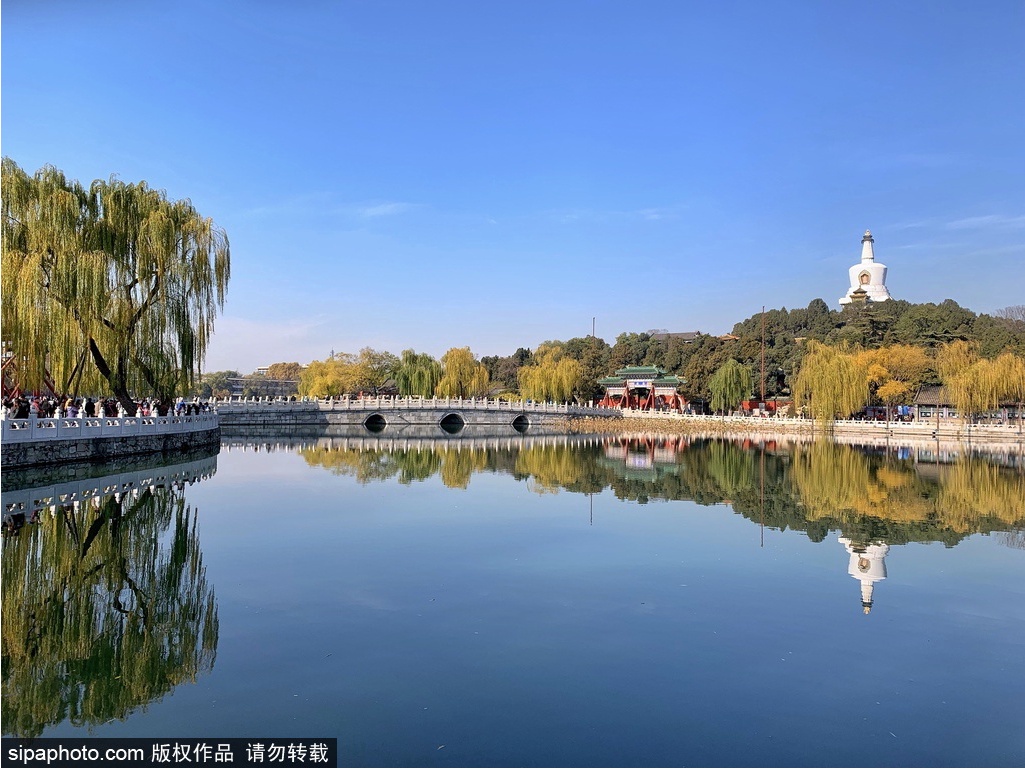
Temple of Eternal Peace
Temple of Eternal Peace is located at the southern foot of White Dagoba Hill in Beihai Park. It was first built in the 8th year of the Shunzhi era (1651 AD) of the Qing Dynasty with the name of White Dagoba Temple by Emperor Shizu (Fu Lin) at the request of Tibetan Lama Naomuhan. The Hall of True Enlightenment, Hall of Universal Peace, Hall of Great Attainment, Hall of Mirror, corner rooms, hill rooms and the White Dagoba were the firstly built structures in the temple. Among them, the Hall of True Enlightenment is the gate to the mountain. In the sixth year of the Qianlong era (1741 AD), the temple was renamed the Temple of Eternal Peace. In the eighth year of the Qianlong era (1743 AD), the Hall of the Wheel of Dharma, Bell Tower, Drum Tower and a new temple gate were added in an effort to expand the temple. In the 16th year of the Qianlong era (1751 AD), the Hall of Good Cause, Pavilion of Enchanting Scenes, and Pavilion of Refreshing Mist were added. In the thirty-ninth year of the Qianlong era (1774 AD), two stone tablets were erected in each pavilion bearing inscriptions "Note on White Dagoba Hill" and "Note on the Surroundings of White Dagoba Hill" in Qianlong Emperor’s calligraphy.
Temple of Eternal Peace is a building complex that reflects religion culture. Strewn at random, multi-colored, and spectacular, it sprawls around as the mountain terrain goes. For historical reasons, some buildings have been destroyed and the statues in them have got lost. In 1993, the Park Administrative Office brought back the initial charm of the temple by carrying out extensive renovations and restoring all the buildings and statues to their original state.
Stele of the Jade Islet in Spring Shade
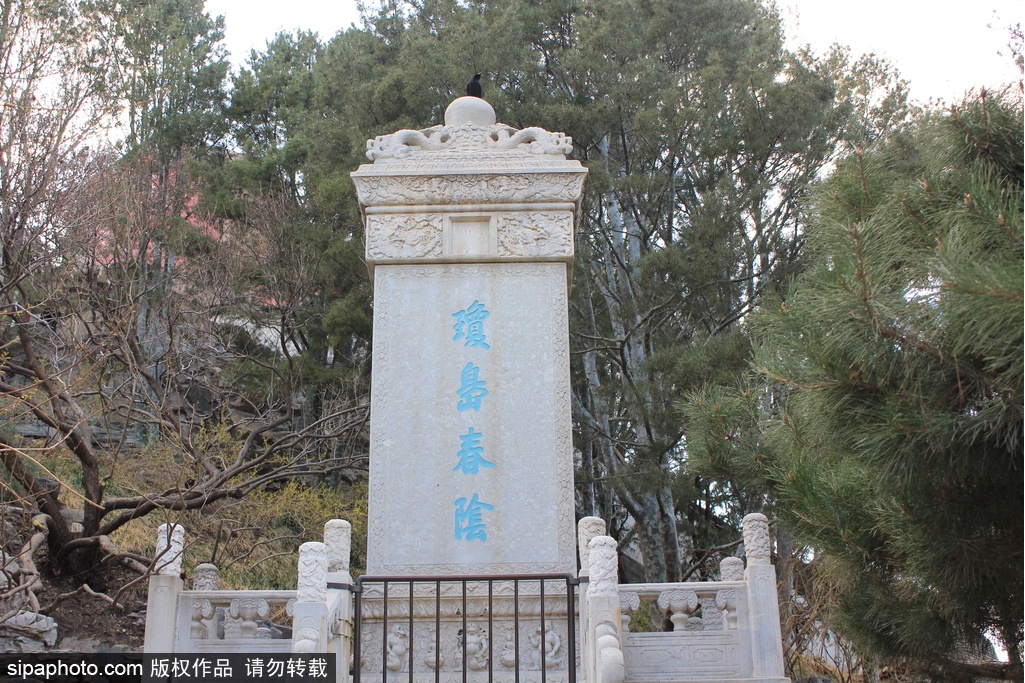
"Jade Islet in Spring Shade" scene was one of the "Eight Great Sights of Yanjing" in the Jin Dynasty. The Stele of the Jade Islet in Spring Shade was erected in the 16th year of the Qianlong era of the Qing Dynasty (1751 AD). The stele has on its front side an inscription "Qiong Dao Chun Yin" written by Qianlong Emperor. The other three sides are inscribed with poems by the emperor.
Round City
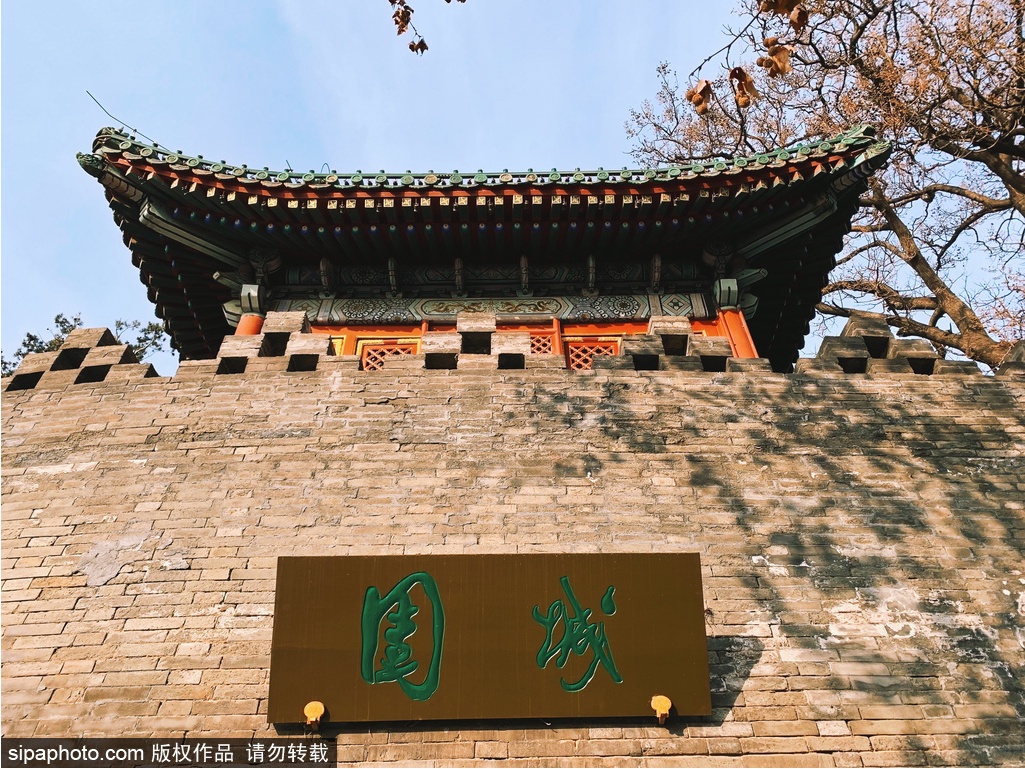
Round City was originally an island in Taiye Lake and a part of Daning Palace in the Jin Dynasty. In the Yuan Dynasty, it was called Yuandi (Round Sandbar) or Yingzhou (Island in the Sea). A city wall encircles the island. The city wall covers an area of about 4,500 square meters surrounded by a 4.6-meter-high and 276-meter long city wall. The palaces, shrouded in vigorous pines and cypresses, in Round City are magnificent and unique. In 1961, the State Council included Round City in the list of key cultural relics under national protection.
Tickets
Peak season (April 1—October 31)
Ticket price: RMB 10 per person; ticket package price: RMB 20 per person
Low season (November 1—March 31)
Ticket price: RMB 5 per person; ticket package price: RMB 15 per person
Ticket price for Jade Islet: RMB 10 per person; ticket package price for Round City: RMB 1 per person
Opening Hours
Beihai Park: 6:00—22:00
Jade Islet Scenic Area: 8:30—18:00
The wharf: 9:00—18:00
Transportation
Take Bus No.5, No.101, No.103, No.109, No.124, No.685, No.814 or No.846 and get off at the front gate of Beihai Park
Take Bus No.13, No.42, No.107, No.111, No.118, No.810, No.701 or No.823 and get off at the back gate of Beihai Park
Address: No.1, Wenjin Street, Xicheng District, Beijing



